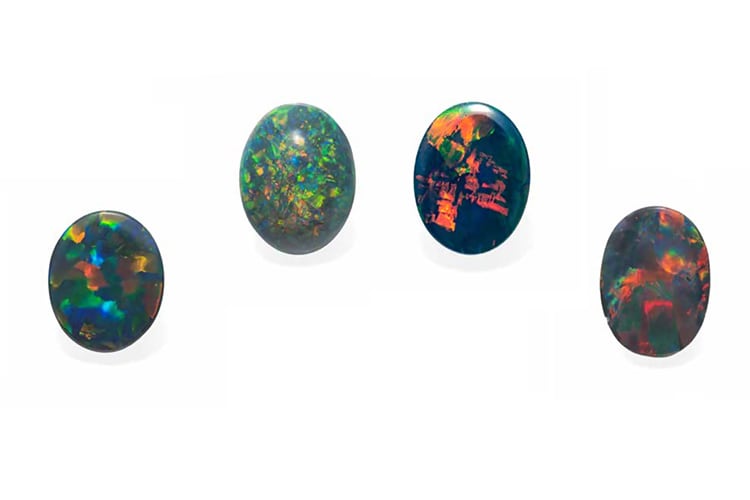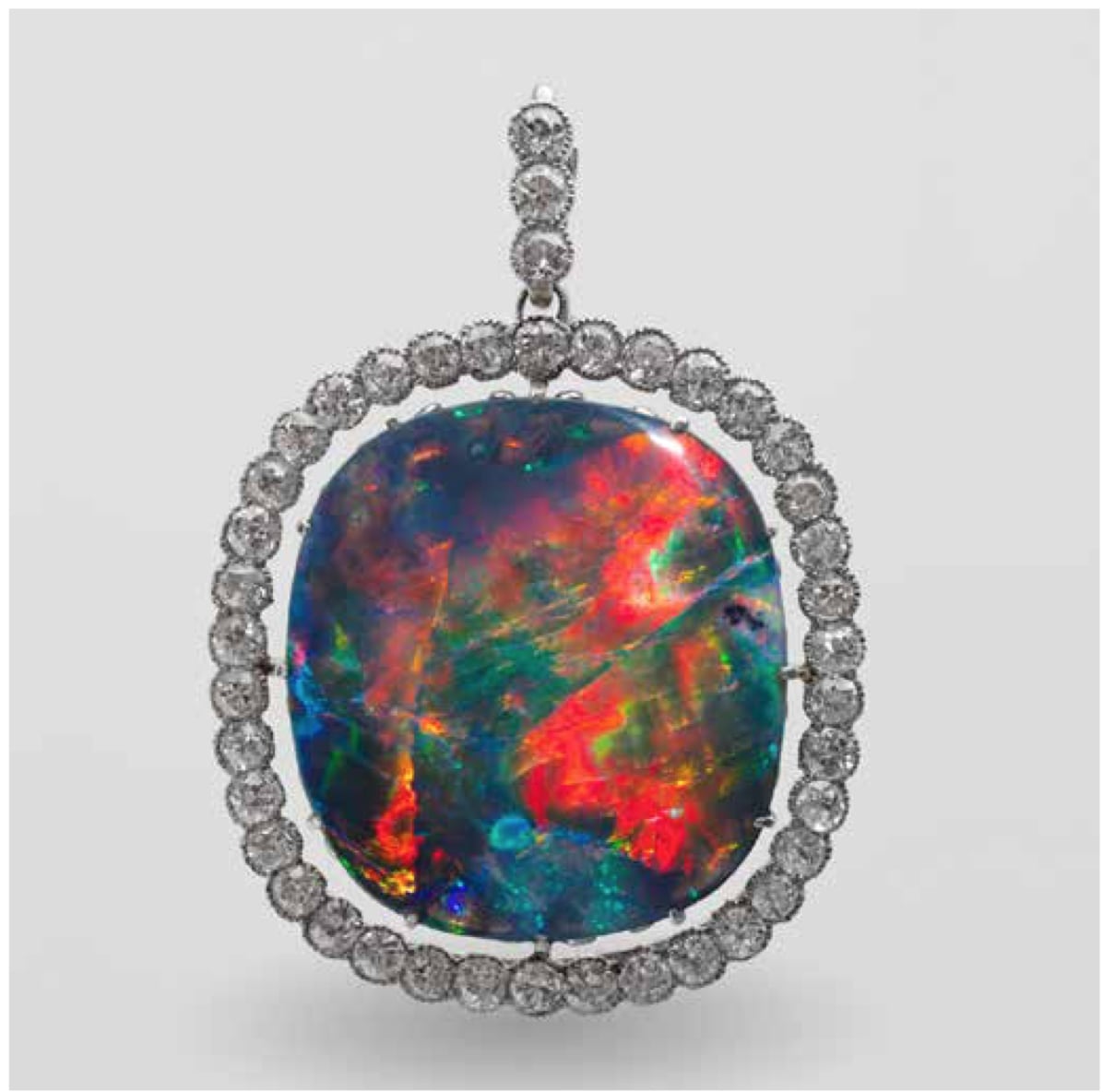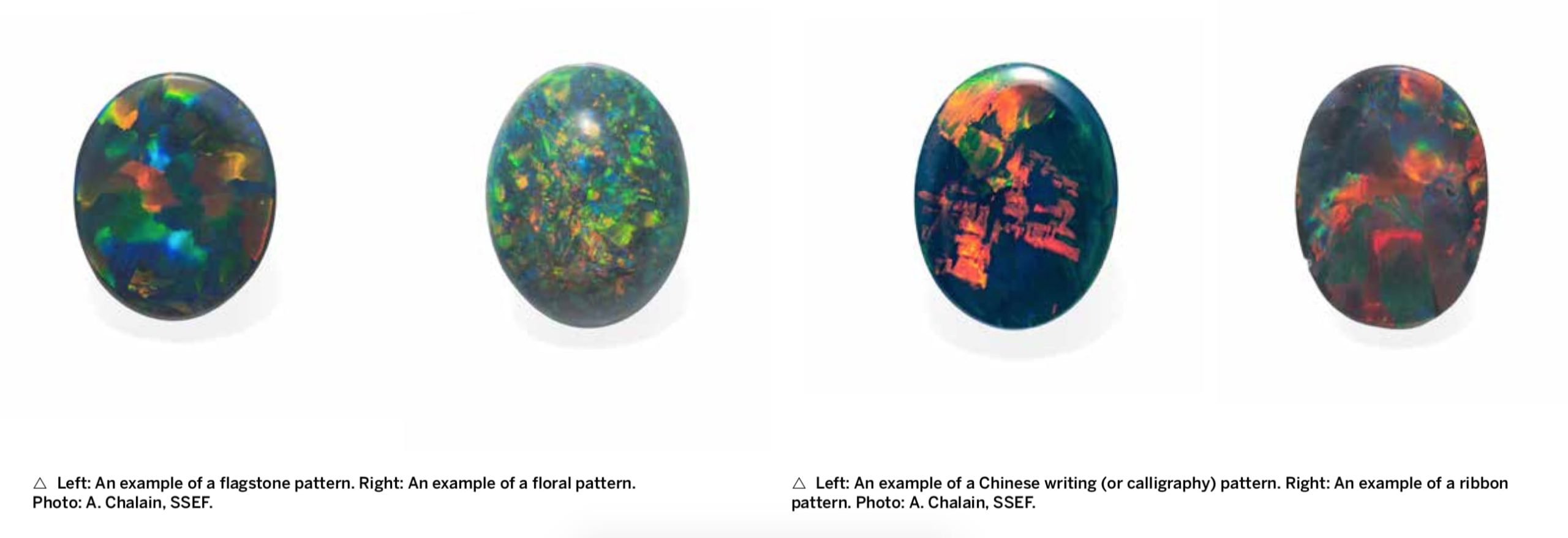The Allure of Black Opals

Opal comes from the Sanskrit upala and the Latin opalus, meaning “precious stone”. The Roman naturalist Pliny the Elder (A.D. 23/24 – 79) wrote that: “In the opal you will see the refulgen fire of the carbuncle (red gems), the glorious purple of amethyst, and the sea green of the emerald, and all these colors glittering together in incredible union”. It is this multitude of colors – play-of-color, also called fire- found in opal that has fascinated humans over time.
Although the Romans had assumed that opals came from the Orient and India, all the early material in fact came from the mines near Červenica in present-day Slovakia (formerly Hungary). Australian opals were discovered in the 19th century. Ethiopian opals are found in the Wollo Province and the Shewa Provinces of Ethiopia with large quantities arriving in the market around 2008. Fire opals were first discovered in Mexico in the state of Querétaro in 1870. Mexico is also home to other types of opals, including white, gray, and black opals. Opals were discovered in Honduras in the 1800s, in Nevada (USA) in the 1900s and in Brazil in the 1930s. Following several NASA rover expeditions, opal has even been discovered on Mars!

Opal is a gemstone that is formed over long periods of time using silica that comes from sedimentary rocks (e.g. sandstone) or volcanic ash, and that is dissolved and transported as a silica gel by water. Opal forms when the silica gel seeps into cracks or voids in rocks, such as sedimentary or volcanic rocks, and begins to harden. As the silica gel hardens, it can form microscopic spheres, which may be arranged in a regular, ordered pattern (Gaillou et al., 2008). The size and arrangement of these spheres determines the play-of-color and pattern of the opal. Sedimentary opals are very common in Australia, whereas Ethiopian and Mexican opals are mostly of volcanic origin (Liesegang and Milke, 2014; Chauviré et al., 2017).
Australia has been the foremost source of high-quality opals since the discovery of opal fields in the late 19th century. There, one can find different varieties such as black opal, white opal and boulder opal. Black opals are known for their deep, rich colors, and their vibrant play-of- color.

Black opal is a type of opal that exhibits a dark background body color, usually black or dark gray. It is considered to be the rarest and most valuable type of opal, and is highly prized for its unique and striking appearance. Black opal is typically found in Australia, specifically in the Lightning Ridge region of New South Wales where it was discovered in 1900. It is formed in a similar way to other types of opal, but the dark body color is due to the presence of tiny dark particles in the silica gel that forms the opal. The dark body color of these opals helps to visually enhance the play-of-color.

Opals are found in a number of locations in Australia. The main deposits all lie within the Great Artesian Basin, the remains of a vast interior sea that covered about a quarter of Australia’s current landmass between 100 million and 250 million years ago. A selection of prominent opal fields in Australia include Lightning Ridge and Coober Pedy. Coober Pedy is located in South Australia, and is home to one of the world’s largest opal fields and is known for its white and boulder opals. Coober Pedy is one of the hottest and driest areas in Australia, opals were discovered there in 1915.
From superstition to haute joaillerie
There is a popular belief that opal brings bad luck to those who wear it, and this belief has persisted for many centuries although the high demand for high-quality opal in recent years suggests otherwise. It is likely a superstition that has been passed down through the ages. The source of this belief is in part due to Sir Walter Scott who blamed a (fire) opal for the death of the beautiful heroine in his 1826 novel Anne of Geierstein. It is thought that this story had a negative impact on how opals were viewed by the bourgeoisie at the time, some going as far to suggest that opals are cursed, yet opal has long also been prized for its beauty and is believed to have many positive associations.
Queen Victoria (1819-1901) and the Art Nouveau movement did much to revive demand for opals. This would also coincide with the discovery of opal deposits in Australia in the 1880s which provided fantastic new material (including black opal) for jewelers to use. The Victorian art critic John Ruskin once fittingly wrote “Everyone knows how capriciously the colors of a fine opal vary from day to day, and how rare the lights are which bring them fully out.” The striking beauty and color diversity of opals was also a source of inspiration for jewelers. Leading Art Nouveau designers such as Erné Lalique, Henri Vever, Georges Fouquet and Louis Comfort Tiffany would use beautiful opals in their designs.
Australian precious opal can command high prices in the market, and there is thus demand for origin determination. Based on the geological history and formation of different deposits there are trace element chemistry differences that allow for origin determination of opals to be conducted (Gaillou et al., 2008). Apart from silicon, the main constituent of opal (SiO2 x nH2O), minor amounts of calcium, potassium, iron, titanium, and traces of manganese, nickel, copper, barium and zirconium, are well known for opals from Australia.

The fascinating world of patterns in black opal
There are many different quality factors that impact the value and rarity of black opal. In addition to factors such as body tone (i.e. degree of darkness) or the dominant diffracted colors (e.g. orange, yellow, green, blue, indigo, violet), patterns are highly sought after by collectors. These patterns can be hard to grade or standardize but are wonderful phenomena to study in black opals (Cody & Cody, 2008). Some of the most desirable patterns found in Australian black opal include: Chinese writing patterns, ribbon patterns, flag stone patterns and floral patterns (see images below).
When admiring these patterns it is hard not to agree with the 18th century English poet James Thomson (who it must be added was not describing opals), which summarizes well the fascination many have with opals and their play-of-color patterns:
“But who can paint
Like Nature? Can imagination boast, Amid its gay creation, hues like hers?”
At the end of the 20th century, major jewelery houses and designers increasingly began to use opals in their designs. This has led to a stronger demand for high-quality black opals over the past two decades. It seems that the fascination for black opal will thrive for decades to come. We are certainly seeing more and more black opals in the lab today.
To learn more about opals, you can take SSEF’s free online course on opals: www.ssef.ch/masterclass
Source: Dr. L.E. Cartier, Facette magazine, SSEF Swiss Gemmological Institute